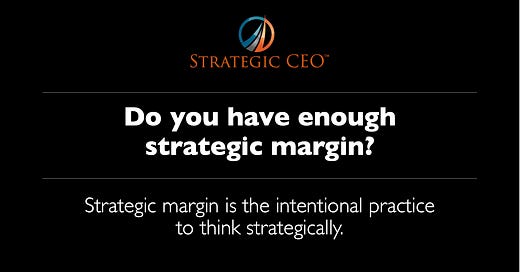Do you have enough strategic margin?
Strategic margin is the intentional practice to think strategically.
→ This is the second in a 7-part series on building strategic capacity in your organization. Part 1 here. Read Part 3 here.←
THINK ON IT: Do you have enough strategic margin?
We all know the importance of having a good strategy for our business. We may even take our teams away once a year to develop an annual plan. But as we discussed in Part 1 of our series on building strategic capacity, it’s not enough to develop a strategy. We need to develop a culture of strategic thinking.
That won’t happen without strategic margin.
Strategic margin not about having room for error in your strategy (although, that’s helpful, too). It’s about cultivating the time in your personal and professional life in order to think strategically. Without strategic margin, you’ll default to firefighting and opportunism.
Dr. Richard Swenson describes margin as the difference between our limits and our load:
MARGIN = LIMITS - LOAD
LIMITS is our total output capacity and LOAD is energy consumed by the demands placed upon us. Our strategic margin–what we have left over to strategically and creatively lead in our businesses and lives–is the difference between the two.
Our LOAD will vary over time. Different stages of our lives and our careers come with their own set of demands on our time. Young children, teens in traveling sports, aging parents… those personal demands can add to our LOAD. So will new job responsibilities, new opportunities, and new challenges.
While we may be able to lessen our LOAD, many of the demands on our time we have little or no control over. We can’t ask our parents to age more gracefully, we can’t tell an acquiring company that we really need them to postpone their offer until a toddler is sleeping through the night, or let a dissatisfied customer know that we really don’t have time to deal with them right now.
When our LOAD exceeds our LIMITS, margin is gone and burnout occurs. There’s no room for strategic thinking, only reacting, or overreacting.
So as strategic leaders, if we want to cultivate strategic thinking in ourselves and our teams, we need to increase our strategic margin. That means we need to find ways to increase our LIMITS, or our strategic capacity.
That’s the subject of our future posts. In the meantime, if you're a paid subscriber, I want to talk to you about the one habit that is doing a big disservice: ditching.(Become a paid subscriber.)
“If you don't have a strategy, you're part of someone else's strategy” — Alvin Toffler
Thanks for being a subscriber to Strategic CEO. If you enjoyed this post, please share it with a friend or colleague.
Keep reading with a 7-day free trial
Subscribe to Strategic CEO to keep reading this post and get 7 days of free access to the full post archives.



